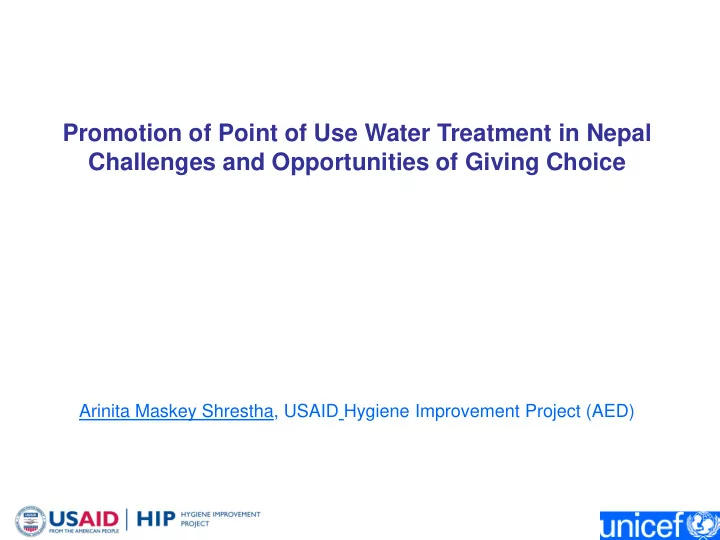

Promotion of Point of Use Water Treatment in Nepal Challenges and Opportunities of Giving Choice Arinita Maskey Shrestha, USAID Hygiene Improvement Project (AED)
Nepal is second richest country on water resources and depends on both surface and ground water for household consumption
Despite advances made in increased access to water supply during the past two decades—37% in 1990 to 82% by 2001 (Central Bureau of Statistics, 2001), - the quality of water remains unacceptably low
Surface Water Quality in Gravity Flow Schemes Fecal Coliform in Gravity Flow Water Supply Schemes in Nepal • Most schemes do not have 38 40 any treatment system % of Samples 26 30 23 • Chemical parameters are 20 normally within WHO 12 10 guideline values 0 • Fecal coliform problem in A B C D majority of the schemes. Contamination level A: No Risk (FC count: 0/100 ml) B: Low Risk (FC: 1-10 / ml) C: High Risk (FC: 11-100 / ml) D: Very High Risk (FC: 101-1000/ml) Source: RWSSFDB, 2001
Ground Water Quality in Terai (Southern Belt ) • Microbial – ENPHO/NRCS conducted P/A test in 14,394 samples & found 47 % to be contaminated • Arsenic – Problem in several Terai districts such as Nawalparasi & Rautahat • Iron – 1260 samples analyzed by ENPHO/NRCS, RWSSFDB, DWSS/UNICEF – 33 % very high (>5 mg/l) – 20 % within WHO GV (0.3 mg/l)
Microbial Contamination in 11 Cities 100 93.6 86.7 Total Coliform 90 83.6 Percent contaminated 78.1 E. Coli 80 66.7 70 57 60 50 40 30 20 10 0 Source Reservoir Tap Water Source Source: ENPHO, 2007 Total Coliforms ranged from 0-2,480 cfu/100 mL and E. coli from 0-1,860 cfu/100 mL. Bacterial counts were particularly high in some samples tested from Banepa, Bhairhawa, Mahendra Nagar, Nepalgunj, Pokhara, Panauti and Taulihawa.
Problems in Water Quality • Most of the supply system do not have treatment provisions before supply • Treated water becomes contaminated due to defective pipe system (leakages, interim supply, illegal connection, pressure etc.) • Water in the household becomes contaminated through unhygienic handling and storage (unclean water storage tank, water storage vessels, water handling practices) in addition…
Perceived Problem with Water Quality 75 80 70 60 percentage 50 40 30 17 16 20 5 10 3 1 1 0 No Turbid Dirty Insects in Bad smell Arsenic Others problem (sand or water mud) 1800 Samples from 4 districts (Dang, Kapilbastu, Parsa, Panchthar) Source: UNICEF/USAID, 2006
2,200 children under five die only of diarrhoea every year in Nepal (NDHS,2006) Incidences of diarhhea is still high though the annual death is said to be decreased 12% of children suffers from diarrhea and it peaks in monsoon season (NDHS,2006) The health sector of Nepal concentrates in curative measures rather than preventive ones Cholera outbreaks- threatening every year even in the highly populated area like Kathmandu City
National Drinking Water Quality Standards- 2006 Implementation Schedule • 1 st Phase (first five years) – All existing urban systems serving over 10,000 people – All new urban water supply systems – All urban systems that are vulnerable to water borne diseases – Urban water supply provider, private industry and health care institutions – Need to prepare water quality improvement plan by 1 year and submit it to relevant ministry as well as Ministry of Health and Population • 2 nd Phase (5 to 10 years) – Within first three years all district headquarters – All rural community based water supply systems (16 parameters)
Hygiene Improvement Project- USAID/UNICEF • Objective: Reduce under-5 morbidity and mortality through: – 50% increase in knowledge of mothers/caretakers - that hand washing with soap and drinking water treatment helps to prevent diarrhea; – 10% increase (80,000 people) in practicing both – 200 primary schools - treating drinking water through installation of safe water options and will practice hand washing with soap – Increased awareness level of the general population (500,000) using mass media campaign; and – Facilitation on integration - in existing regular programs of public and NGO sector water, sanitation and health programs
USAID/UNICEF/HIP project area Piloted in 4 districts - representing 4 regions ( about 500,000 HH) Schools- 200
Household Drinking Water Treatment Methods
Advocacy/ POU Activities integration in regular programs of WATSAN stakeholders/ institutionalization Capacity Generic Ensure Product Building Promotion availability (Demand) (Supply) Orientation National National Strategy/Policy Product improvement Regional on POU IEC with good QC District Mass Distribution Network & Media Master Trainings continuous supply Strengthen supply chain Training to CW s through Private Sector (FCHVs,HWs, Partnership Women’s grp, youth grp etc Local Market School child clubs training Door to Door visits, Street drama, Group Households discussions/orientation School and catchment area promotion,Cultrual program ,Promotion through health network, option demonstration, monitoring
Recommend
More recommend